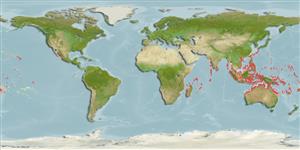Common names from other countries
>
Gobiiformes (Gobies) >
Gobiidae (Gobies) > Gobiinae
Etymology: Priolepis: Greek, prio = to saw + Greek,lepis = scale (Ref. 45335); inhaca: Named for its type locality, Inhaca Island, Mozambique (Ref. 10753).
More on author: Smith.
Environment: milieu / climate zone / depth range / distribution range
Sinh thái học
Biển Cùng sống ở rạn san hô; không di cư; Mức độ sâu 12 - 26 m (Ref. 1602). Tropical; 30°N - 27°S
Indo-Pacific: East Africa to Taiwan and the Society Islands.
Bộ gần gũi / Khối lượng (Trọng lượng) / Age
Maturity: Lm ? range ? - ? cm
Max length : 4.0 cm TL con đực/không giới tính; (Ref. 2798)
Short description
Khóa để định loại | Hình thái học | Sinh trắc học
Các tia vây lưng cứng (tổng cộng) : 7; Các vây lưng mềm (tổng cộng) : 9 - 10; Tia cứng vây hậu môn: 1; Tia mềm vây hậu môn: 8. This species has a few, relatively narrow (less than pupil diameter) light bars on the head (Ref. 37816); characterized by pinkish grey with dark brown scale edges forming a network; presence of three pale vertical lines below eye and interconnected pale lines on top of head; absence of pelvic frenum; longitudinal scale series 26-28; predorsal scales 12-17; ctenoid body scales; cycloid scales on pectoral fin base, breast and midlaterally on abdomen; opercle of adult with cycloid scales; predorsal scales absent; posterior edge of tubular posterior nostril adherent to edge of orbit; cheek with single vertical row of papillae; depth of body 4.0 in SL (Ref. 90102).
Has been collected from lagoons and drop-offs (Ref. 1602). Also found in reef crevices (Ref. 90102).
Life cycle and mating behavior
Maturities | Sự tái sinh sản | Spawnings | Egg(s) | Fecundities | Ấu trùng
Hoese, D.F., 1986. Gobiidae. p. 774-807. In M.M. Smith and P.C. Heemstra (eds.) Smiths' sea fishes. Springer-Verlag, Berlin. (Ref. 2798)
IUCN Red List Status (Ref. 130435)
CITES (Ref. 128078)
Not Evaluated
Threat to humans
Harmless
Human uses
Các công cụ
Special reports
Download XML
Các nguồn internet
Estimates based on models
Preferred temperature (Ref.
115969): 25.2 - 28.9, mean 27.7 (based on 214 cells).
Phylogenetic diversity index (Ref.
82804): PD
50 = 0.5000 [Uniqueness, from 0.5 = low to 2.0 = high].
Bayesian length-weight: a=0.01023 (0.00477 - 0.02194), b=3.02 (2.84 - 3.20), in cm Total Length, based on LWR estimates for this (Sub)family-body shape (Ref.
93245).
Mức dinh dưỡng (Ref.
69278): 3.1 ±0.3 se; based on size and trophs of closest relatives
Thích nghi nhanh (Ref.
120179): Chiêù cao, thời gian nhân đôi của chủng quần tối thiểu là dưới 15 tháng (Preliminary K or Fecundity.).
Fishing Vulnerability (Ref.
59153): Low vulnerability (10 of 100).
